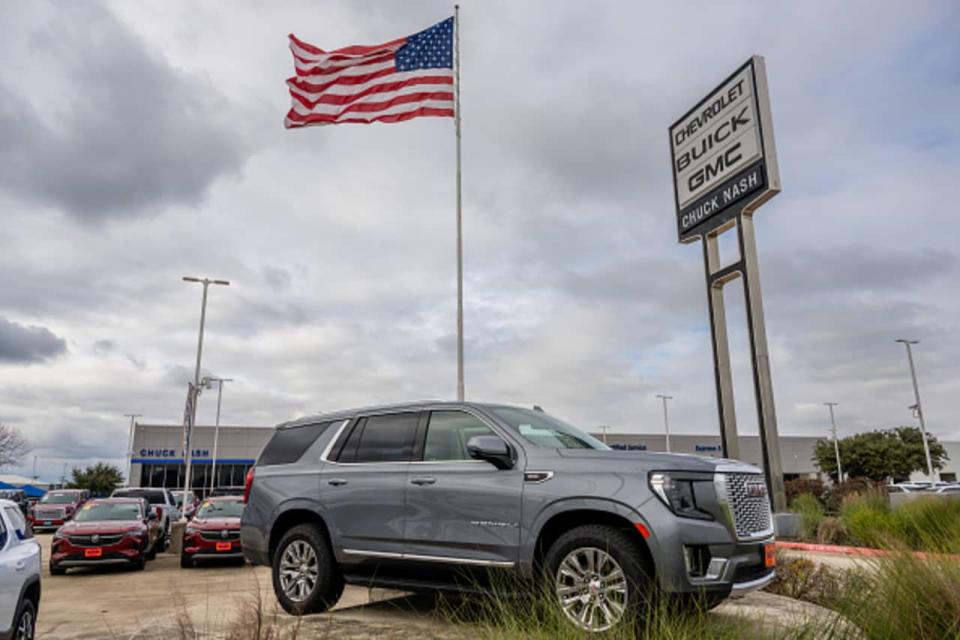A $1,400 SUV payment? A $1,600 truck payment? Sounds ‘absurd,’ but it’s becoming more common.

A TikTok user who goes by the name Blaisey Arnold says she has two massive car payments every month: one for her Chevy Tahoe SUV, which she financed for $84,000 at a 10% interest rate, and the other for her husband’s GMC Sierra 1500 AT4 pickup truck, financed for $78,000 at 14%.
Most Read from MarketWatch
Some Apple Vision Pro users suffer black eyes, headaches and neck pain
SoundHound plans to sell stock after big rally, and its shares are sliding
Costco boosts its dividend by 14% while touting sharp rise in e-commerce sales
The monthly payment on her Tahoe is $1,400, she says, and the Sierra payment is $1,600.
“Why did I do this to myself?” wonders Arnold in one video, which has 2.5 million views. Viewers on TikTok expressed disbelief, confusion and shock about her costs in the comments. Some said that they pay less for housing than Arnold does for the two vehicles. Others directly faulted her money management. Arnold did not respond to interview requests from MarketWatch.
Her conundrum is extreme: She financed the cars, it appears, in late 2021 and in 2022 at higher-than-average interest rates — the average rate for new-car loans ranged from about 4.3% in January 2022 to 6.7% in December 2022 — and she also chose to finance two pricey vehicles at once. But she is one of a growing number of Americans with car payments of $1,000 or more due to rising car prices and interest rates.
By this February, 17.4% of new cars were financed with a monthly payment of over $1,000, compared with 5% in February 2020, according to data from the car site Edmunds. Over the same period, the average transaction price for new vehicles jumped from $38,130 to $47,060, and the average interest rate on new-car loans went from 5.7% to 7.1%.
About 70% of monthly payments on large SUVs like the Tahoe are at least $1,000, and for large trucks such as a Sierra, that share is over 40%, said Joseph Yoon, a consumer-insights analyst at Edmunds. These cars are not uncommon, either: Large trucks are the third-best-selling category in the U.S., after compact and midsize SUVs, and the GMC Sierra was the seventh most popular car last year, according to Edmunds. The Chevy Tahoe was the 24th most popular SUV in 2023, with more than 110,000 units sold, according to Kelley Blue Book.
General Motors GM, parent company to both Chevrolet and GMC, didn’t immediately respond to a request for comment. The base manufacturer’s suggested retail price for a 2024 Chevy Tahoe ranges from $54,600 to $79,900, according to Edmunds. The base MSRP for a GMC Sierra 1500 is $43,400 to $82,500.
While a $1,000 car payment is becoming more common, and about 59% of U.S. households have more than one car, financing two vehicles at rates as high as Arnold’s “is an absurd amount of money,” Yoon said. The average car-loan balance in 2023 was $23,792, according to Experian, up 5.2% from the previous year.
Arnold borrowed $162,000 in total for her two cars, according to her videos. “For those cars, they’re not great deals, but they’re not the worst deals that I’ve seen,” Yoon said. “And that’s the craziness of what has happened in the last couple of years.”
Arnold doesn’t disclose her income in the videos, although she characterizes what she makes as a healthy sum. She revealed her intention of selling the Tahoe because she didn’t want to make payments on it anymore, observing that she’d only paid down $10,000 in principal while forking over some $50,000 in monthly loan payments. She bought a used Audi VWAGY XE:VOW with cash, she says in one video.
Arnold says in a new video posted this week that she intends to pay off her $10,000 credit-card debt with earnings from social media and will cover expenses with cash from now on, rather than using borrowed funds.
Used cars, despite price increases in recent years, remain more affordable than new cars. The average used-car price in February was $26,752, and about one-third of used cars were purchased with cash or outside financing, rather than dealer financing, compared with one-fourth of new cars, according to Edmunds.
New-car prices have recently started to decline, and experts expect that used-car prices will eventually ease as well.
A rule of thumb for car payments is to spend less than 10% of your monthly take-home pay on car payments, and no more than 15% to 20% on transportation costs, which, for those who own cars, include a car payment, insurance and fuel. But as Yoon points out, such guidelines aren’t always realistic for people who are struggling with the rising cost of living.
In 2022 the average household expenditure for transportation was $12,295, accounting for 14.8% of after-tax income, according to the Bureau of Transportation Statistics. People in the lowest income bracket spent the least on transportation, at $4,928, but that still represented 30.2% of their after-tax income, compared with 11.6% — or $22,926 on average — for people in the highest income bracket.
“Whatever the rule of thumb is … sometimes you literally cannot do that,” Yoon said. “And I think that’s becoming more and more common for a lot of families.”
How have higher prices affected your life and how you think about the U.S. economy? Let us know at readerstories@marketwatch.com. One of our reporters might reach out to you to learn more.
